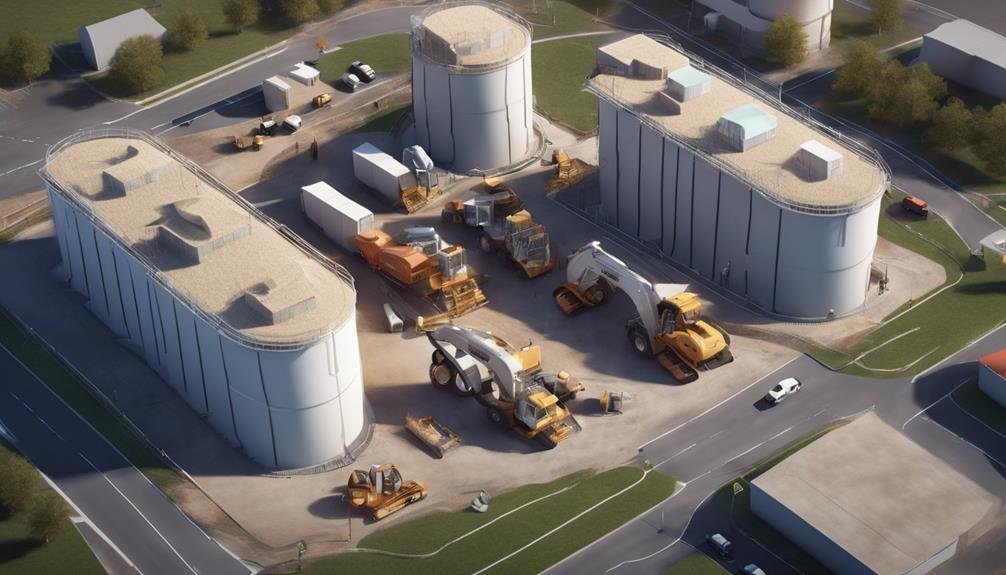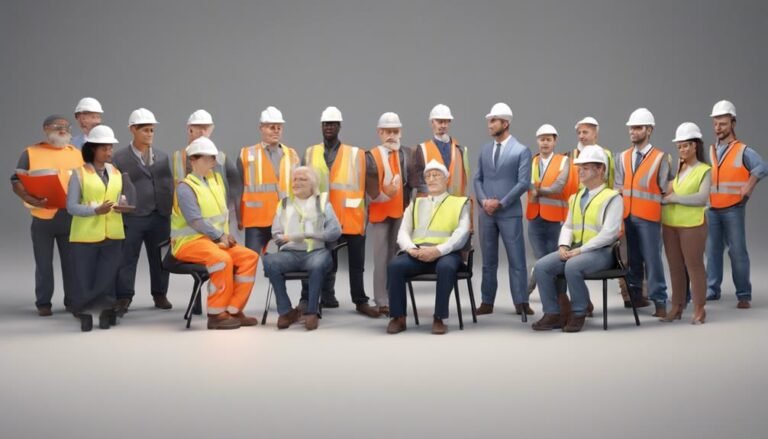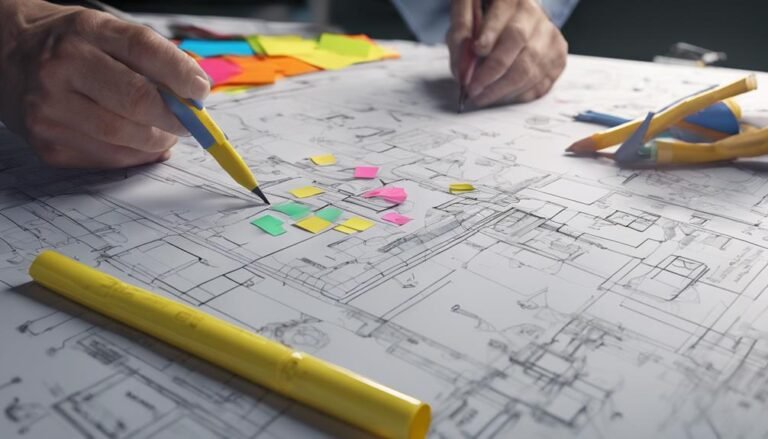Interdepartmental Communication: Breaking Down Silos in Construction Firms
In your construction firm, breaking down silos with strong interdepartmental communication is key. It boosts efficiency, fosters collaboration, and builds a united team. Overcoming challenges like resistance to change and cultural barriers is possible by creating intentional strategies, holding regular meetings, and forming cross-functional teams. Using technology tools and providing training programs can further enhance communication. Improved collaboration leads to streamlined processes, quicker project delivery, and innovation. Learn how successful case studies highlight the benefits of integrated teamwork, guiding you towards seamless flow of information and enhanced productivity in your construction projects.
Key Takeaways
- Implement intentional strategies for seamless collaboration.
- Foster unity through regular interdepartmental meetings.
- Utilize cross-functional teams to leverage diverse skills.
- Build trust and teamwork with team-building exercises.
- Develop a shared sense of purpose among employees.
Importance of Interdepartmental Communication
To enhance operational efficiency and foster collaboration within construction firms, prioritizing strong interdepartmental communication is essential. Team building plays an important role in creating a cohesive work environment where employees from different departments can come together to achieve common goals. Encouraging team building activities such as group projects, cross-departmental training sessions, or team-building exercises can help break down silos and improve communication among departments. These activities not only improve relationships between team members but also enhance trust and understanding, leading to smoother collaboration on projects.
Collaboration techniques are also crucial in promoting interdepartmental communication. Implementing strategies such as regular cross-departmental meetings, project management tools for shared visibility, and fostering a culture of open communication can significantly enhance collaboration within construction firms. By encouraging departments to work closely together, share information, and contribute their unique expertise to projects, construction firms can break down silos and create a more cohesive and efficient working environment. Prioritizing team building and implementing effective collaboration techniques can lead to improved communication, increased productivity, and ultimately, greater success for construction firms.
Challenges in Siloed Construction Firms
In the world of construction firms, maneuvering through silos presents a myriad of challenges that hinder efficient operations and collaboration. Overcoming resistance and fostering teamwork can be particularly challenging tasks when departments operate in isolation. Resistance to change or sharing information can create barriers that impede progress and innovation. Additionally, addressing cultural barriers is vital in promoting collaboration across different departments. Diverse teams may struggle to align on common goals or methodologies, leading to disjointed efforts and misunderstandings.
In siloed construction firms, the lack of communication channels exacerbates these challenges, making it difficult for teams to coordinate effectively. Misaligned priorities and conflicting strategies often arise due to the silo mentality, further complicating project timelines and outcomes. To navigate these obstacles successfully, it's essential for organizations to prioritize transparency, open dialogue, and a unified vision. By breaking down these silos and fostering a culture of collaboration, construction firms can enhance efficiency, productivity, and overall success in their projects.
Strategies for Cross-Department Collaboration
Breaking down silos in construction firms requires intentional strategies that promote seamless collaboration across departments. To enhance cross-department collaboration, implementing effective collaboration techniques and engaging in team-building exercises are essential.
One strategy is to hold regular interdepartmental meetings where team members from different departments can share updates, ideas, and challenges. These meetings foster communication and create a sense of unity among departments. Additionally, establishing cross-functional teams to work on specific projects encourages employees to collaborate across departments, leveraging diverse skills and knowledge.
Team-building exercises are another powerful tool to break down barriers and promote collaboration. These exercises can range from outdoor activities to problem-solving challenges, all aimed at fostering trust, communication, and teamwork among employees from different departments. By participating in such activities, employees learn to appreciate each other's strengths, build stronger relationships, and develop a shared sense of purpose.
Technology Solutions for Communication Breakdowns
Enhancing communication within construction firms can be facilitated through the strategic implementation of technology solutions to address any breakdowns in communication channels. When it comes to improving interdepartmental communication, leveraging technology can make a significant difference.
Here are three key technology solutions to enhance communication breakdowns:
- Virtual Meetings: Conducting virtual meetings through platforms like Zoom or Microsoft Teams can bring together team members from different departments regardless of their physical location. These tools allow for face-to-face interactions, fostering collaboration and reducing misunderstandings.
- Collaboration Tools: Utilizing project management software such as Trello or Asana enables teams to work together seamlessly by sharing documents, assigning tasks, and tracking progress in real-time. These tools promote transparency and accountability among team members.
- Remote Work Communication Platforms: Platforms like Slack or Microsoft Teams provide channels for instant messaging, file sharing, and group discussions, facilitating quick and efficient communication, especially for remote teams. By utilizing these platforms, employees can stay connected and informed, reducing communication gaps and enhancing overall productivity.
Training Programs for Interdepartmental Communication
Ready to enhance interdepartmental communication in your construction firm?
Through role-playing exercises and communication workshops, your team can develop essential skills to break down silos and foster collaboration.
These programs provide practical scenarios to practice effective communication strategies, ultimately leading to smoother workflows and improved project outcomes.
Role-Playing Exercises
Utilizing role-playing exercises can greatly enhance interdepartmental communication within construction firms, fostering collaboration and understanding among team members. Here's how role-playing exercises can benefit your team:
- Communication simulation: By simulating real-life work scenarios through role-playing, employees can practice effective communication strategies, learn to listen actively, and improve their conflict resolution skills.
- Team building exercises: Role-playing encourages employees from different departments to work together, breaking down communication barriers and building trust among team members.
- Enhanced problem-solving: Through role-playing exercises, employees can tackle complex problems collaboratively, fostering innovative solutions and improving overall decision-making processes.
Communication Workshops
Communication workshops are essential for fostering effective interdepartmental communication within construction firms, enabling teams to collaborate seamlessly and achieve project success.
These workshops often incorporate interactive simulations and real-life scenarios to help employees understand how to navigate various communication styles and personality traits. By participating in these training programs, team members can practice active listening, conflict resolution, and assertiveness in a safe environment.
Through hands-on activities and guided discussions, employees can gain insights into their own communication tendencies and learn how to adapt them to work more cohesively with colleagues from different departments.
Ultimately, communication workshops play a crucial role in breaking down silos, improving teamwork, and enhancing overall project outcomes in construction firms.
Benefits of Integrated Teamwork in Construction
Integrated teamwork in construction maximizes efficiency and fosters collaboration among different project stakeholders. When teams work together seamlessly, the benefits are significant:
- Improved Efficiency: By breaking down silos and encouraging cross-departmental collaboration, tasks are completed more efficiently. Team members can leverage each other's expertise, leading to streamlined processes and quicker project delivery.
- Enhanced Productivity: Integrated teamwork eliminates redundant efforts and minimizes misunderstandings. With clear communication channels and shared goals, team members can focus on their specific roles, knowing that others are working concurrently towards the same objectives.
- Boosted Innovation: Collaborative teamwork often sparks creativity and innovation. When individuals from various departments come together, they bring diverse perspectives and ideas to the table. This blend of viewpoints can lead to novel solutions and improvements in project outcomes.
In construction, where time and precision are critical, integrated teamwork not only benefits individual team members but also contributes to the overall success of the project.
Case Studies: Successful Communication Integration
Breaking down silos and fostering collaboration in construction firms have shown remarkable results in improving project outcomes. In examining case studies of successful communication integration, one can observe the tangible benefits that effective teamwork brings to construction projects. Real-world examples highlight how implementing best practices in interdepartmental communication leads to smoother project execution and enhanced overall performance.
Industry insights gathered from these case studies emphasize the importance of communication models that facilitate seamless information flow across different teams within a construction firm. By adopting such communication models, construction companies can streamline processes, reduce errors, and enhance productivity.
These successful integration stories serve as guiding beacons for firms looking to break down silos and promote cross-departmental collaboration. By learning from these experiences and implementing similar strategies, construction companies can create a culture of open communication, teamwork, and shared goals, ultimately leading to improved project outcomes and client satisfaction.
Conclusion
As you navigate the complex landscape of interdepartmental communication in construction firms, remember that breaking down silos is like building a strong foundation for a skyscraper. Just as each brick supports the structure, each department working together creates a cohesive and successful team.
Embrace collaboration, technology, and training to guarantee seamless communication flow, and watch your projects soar to new heights. Together, you can construct a future where teamwork is the cornerstone of success.







